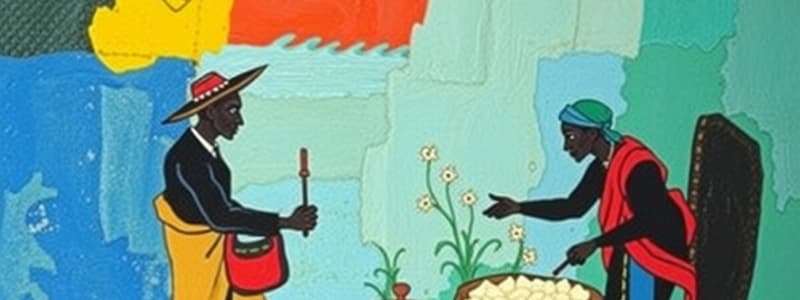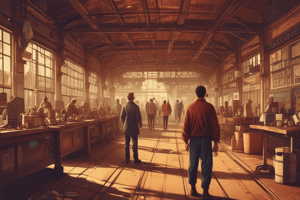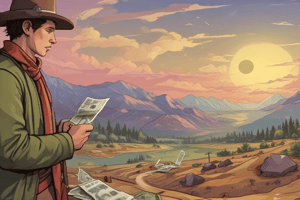Podcast
Questions and Answers
What is the definition of productivity?
What is the definition of productivity?
- The marketing strategies employed by a company.
- The number of employees working in a business.
- The efficiency of using resources to create output. (correct)
- The total amount of goods produced by a business.
Which of the following is NOT a level of production?
Which of the following is NOT a level of production?
- Surplus
- Subsistence
- Industrial (correct)
- Domestic
What is one example of primary production?
What is one example of primary production?
- Clerical work
- Baking bread
- Car manufacturing
- Fishing (correct)
What is one remedy for breach of contract?
What is one remedy for breach of contract?
How is labor productivity calculated?
How is labor productivity calculated?
Which of the following describes secondary production?
Which of the following describes secondary production?
In the context of productivity, what does 'output' refer to?
In the context of productivity, what does 'output' refer to?
What happens at the surplus level of production?
What happens at the surplus level of production?
What does the principle of Utmost Good Faith require from an insured individual?
What does the principle of Utmost Good Faith require from an insured individual?
What does the Contribution principle ensure in the case of multiple insurance policies?
What does the Contribution principle ensure in the case of multiple insurance policies?
Under which condition can an individual not insure their property?
Under which condition can an individual not insure their property?
What happens in the case of an Average Claim?
What happens in the case of an Average Claim?
What does the Proximate Clause relate to?
What does the Proximate Clause relate to?
What is the role of Arbitration in insurance claims?
What is the role of Arbitration in insurance claims?
What does it mean to cancel an insurance policy?
What does it mean to cancel an insurance policy?
If a loss is caused by a third party after the insured has made a claim, what is the insured's next step?
If a loss is caused by a third party after the insured has made a claim, what is the insured's next step?
What is one responsibility management has towards shareholders?
What is one responsibility management has towards shareholders?
Which of the following is a responsibility of management to customers?
Which of the following is a responsibility of management to customers?
Which responsibility does management have to the government?
Which responsibility does management have to the government?
In what way is management responsible to society?
In what way is management responsible to society?
What is a key aspect of ensuring good management leadership?
What is a key aspect of ensuring good management leadership?
What type of insurance is primarily focused on paying claims to beneficiaries upon the death of the policy owner?
What type of insurance is primarily focused on paying claims to beneficiaries upon the death of the policy owner?
Which insurance type compensates for property loss due to fire?
Which insurance type compensates for property loss due to fire?
What is a characteristic of Whole Life Insurance?
What is a characteristic of Whole Life Insurance?
Which insurance policy is usually taken by financial institutions against the life of a borrower?
Which insurance policy is usually taken by financial institutions against the life of a borrower?
Which document serves as proof of a transaction within a business?
Which document serves as proof of a transaction within a business?
What type of insurance provides compensation for consequences beyond direct property damage due to events like a fire?
What type of insurance provides compensation for consequences beyond direct property damage due to events like a fire?
What is the primary function of a business document?
What is the primary function of a business document?
Which of the following is NOT a type of Non-Life Insurance?
Which of the following is NOT a type of Non-Life Insurance?
What is the primary purpose of a purchase requisition?
What is the primary purpose of a purchase requisition?
Which document serves as a sealed bid for competitive work typically in the construction industry?
Which document serves as a sealed bid for competitive work typically in the construction industry?
What does a credit note primarily adjust?
What does a credit note primarily adjust?
What information is typically included in a proforma invoice?
What information is typically included in a proforma invoice?
Which document provides details necessary for customs officials to process imported goods?
Which document provides details necessary for customs officials to process imported goods?
What does an invoice replicate?
What does an invoice replicate?
Which document is typically used to inform suppliers about a customer's intention to purchase goods?
Which document is typically used to inform suppliers about a customer's intention to purchase goods?
What is the main function of a statement of account?
What is the main function of a statement of account?
What is a primary effect of external migration on a community or country?
What is a primary effect of external migration on a community or country?
Which of the following best describes the concept of capital in production?
Which of the following best describes the concept of capital in production?
What role does an entrepreneur play in the factor of production?
What role does an entrepreneur play in the factor of production?
Which factor is NOT considered when determining the location of an industry?
Which factor is NOT considered when determining the location of an industry?
Why might a firm choose to remain small?
Why might a firm choose to remain small?
What is one reason for the expansion of large firms?
What is one reason for the expansion of large firms?
Which of the following best describes the contribution of small firms to the economy?
Which of the following best describes the contribution of small firms to the economy?
Which factor does NOT directly influence the success of small businesses?
Which factor does NOT directly influence the success of small businesses?
Flashcards
Utmost Good Faith
Utmost Good Faith
You must be honest with the insurance company and provide all necessary information to assess the risk.
Contribution
Contribution
When multiple insurers cover the same item, they share the cost of a loss proportionally.
Subrogation
Subrogation
If someone causes you harm, you can claim compensation from them, not just your insurance company.
Cancellation
Cancellation
Signup and view all the flashcards
Legality
Legality
Signup and view all the flashcards
Arbitration
Arbitration
Signup and view all the flashcards
Average Clause
Average Clause
Signup and view all the flashcards
Proximate Clause
Proximate Clause
Signup and view all the flashcards
Life Assurance
Life Assurance
Signup and view all the flashcards
Non-Life Insurance
Non-Life Insurance
Signup and view all the flashcards
Marine Insurance
Marine Insurance
Signup and view all the flashcards
Fire Insurance
Fire Insurance
Signup and view all the flashcards
Whole-Life Assurance
Whole-Life Assurance
Signup and view all the flashcards
Mortgage Guarantee
Mortgage Guarantee
Signup and view all the flashcards
Annuities
Annuities
Signup and view all the flashcards
Endowment Assurance
Endowment Assurance
Signup and view all the flashcards
Purchase Requisition
Purchase Requisition
Signup and view all the flashcards
Quotation (Estimate)
Quotation (Estimate)
Signup and view all the flashcards
Tender
Tender
Signup and view all the flashcards
Invoice
Invoice
Signup and view all the flashcards
Credit Note
Credit Note
Signup and view all the flashcards
Proforma Invoice
Proforma Invoice
Signup and view all the flashcards
Import and Export Licenses
Import and Export Licenses
Signup and view all the flashcards
Certificate of Origin
Certificate of Origin
Signup and view all the flashcards
Responsibilities to shareholders
Responsibilities to shareholders
Signup and view all the flashcards
Responsibilities to customers
Responsibilities to customers
Signup and view all the flashcards
Responsibilities to the government
Responsibilities to the government
Signup and view all the flashcards
Responsibilities to employees
Responsibilities to employees
Signup and view all the flashcards
Effective management
Effective management
Signup and view all the flashcards
What is a breach of contract?
What is a breach of contract?
Signup and view all the flashcards
One remedy for a breach of contract?
One remedy for a breach of contract?
Signup and view all the flashcards
How can a contract be terminated?
How can a contract be terminated?
Signup and view all the flashcards
What is production?
What is production?
Signup and view all the flashcards
What is productivity?
What is productivity?
Signup and view all the flashcards
How do you calculate productivity?
How do you calculate productivity?
Signup and view all the flashcards
What is the subsistence level of production?
What is the subsistence level of production?
Signup and view all the flashcards
What is the domestic level of production?
What is the domestic level of production?
Signup and view all the flashcards
Brain Drain
Brain Drain
Signup and view all the flashcards
Capital
Capital
Signup and view all the flashcards
Entrepreneur
Entrepreneur
Signup and view all the flashcards
Cost of Brain Drain
Cost of Brain Drain
Signup and view all the flashcards
Factors affecting industry location
Factors affecting industry location
Signup and view all the flashcards
Small Firms
Small Firms
Signup and view all the flashcards
Large Firms
Large Firms
Signup and view all the flashcards
Benefits of Small Firms
Benefits of Small Firms
Signup and view all the flashcards
Study Notes
Economic Activities
- Man is an economic animal, engaging in production, consumption (trade), and exchange (barter) to satisfy basic needs like food, clothing, and shelter.
- Direct satisfaction of wants occurs when individuals produce goods and services for personal consumption.
- Indirect satisfaction of wants occurs through trade, potentially in the form of barter or monetary exchange.
Trade: Barter
- Barter involves the exchange of goods or services without using money.
- Two conditions must be met for a barter transaction:
- Double coincidence of wants: Each party must desire what the other party offers.
- Agreement on the rate of exchange: Both parties must agree on the exchange ratio.
Disadvantages of Barter
- Limited range of wants that can be satisfied.
- Time-consuming search for suitable exchange partners.
- Delay in transaction completion.
- Difficulty in determining fair exchange value.
- Perishable goods cannot be stored for future exchange.
- Merchandise may be indivisible.
Money
- Money is anything generally accepted as a means of settling debts.
- It includes notes, coins, and bank deposits.
Characteristics of Money
- Acceptability: Widely accepted by everyone.
- Durability: Resistant to wear and tear.
- Divisibility: Can be divided into smaller units.
- Portability: Easily carried and moved.
- Homogeneity: Identical units have the same value.
Functions of Money
- Medium of exchange: Facilitates the exchange of goods and services.
- Unit of account: Measures the value of goods and services.
- Store of value: Can be saved and used for future transactions.
- Standard of deferred payment: Used to settle debts in the future.
Money and Capital Market
- The money market deals with short-term borrowing and lending.
- The capital market deals with long-term finance such as stocks, shares, and home loans.
- Key participants include commercial banks, merchant banks, and finance houses.
Insurance
- Insurance compensates for losses due to events like fire, hurricanes, or accidents.
- Assurance is compensation for losses that must happen, like death.
- Insurance is based on the principle of the fortunate assisting the unfortunate.
- A premium is the payment made to receive insurance coverage.
- An insurance policy is the agreement between the insurer and insured.
Principles of Insurance
- Indemnity: Insurer only compensates for actual loss.
- Insurable interest: Insurer must potentially suffer a loss.
- Utmost good faith: All relevant information must be disclosed.
- Contribution: Loss shared if insured by multiple insurers.
- Subrogation: Insurer can recover losses from liable parties.
- Cancellation: Policy can be canceled under specific provisions.
- Legal provision: Insurance contracts must conform to valid legal standards.
Types of Insurance
- Life assurance: For losses related to death.
- Non-life insurance: For unexpected events.
- Marine insurance: For goods or people traveling by sea.
- Fire insurance: Against losses from fire.
- Consequential losses: For losses resulting from another event (e.g., loss of profit due to fire).
- Whole-life insurance: Payable upon the insured's death.
Types of Insurance Documents
- Insurance certificate
- Bill of exchange
- Airline bill
- Debit note
- Legal tender
- Postal order
- Money order
- Telegraphic money order
- International money order/bank draft
Cheques
- Personal cheques: Drawn on current accounts.
- Manager cheques: Issued by banks for large amounts.
- Cross cheques: Can only be deposited, not cashed.
- Certified cheques: Bank-certified for validity.
- Travelers cheques: For use by travelers in foreign countries.
- Credit cards: Allow for payment without cash.
- Standing orders: Regular payments on specific dates.
Contract Essentials
- Offer and acceptance: One party offers, the other accepts.
- Consideration: Something of value exchanged by both parties
- Legality: Contract must be legal.
- Intention to create legal relations
- Certainty: Terms of agreement must be clear
- Capacity to contract: Parties must have the legal ability to enter into a contract.
- Genuineness: Parties must enter into the contract willingly and with fair understanding.
Types of Contracts
- Simple contracts: Can be oral, written or implied.
- Contracts by deed or specialty contracts: Must be under seal, to have legal value.
- Contracts of record: Imposed by the courts.
Termination of Contracts
- Performance: Completion of contractual duties.
- Breach: Failure to fulfill contractual obligations.
- Impossibility: An event makes performance impossible.
- Lapse of time: Expiration of a deadline.
- Mutual agreement: Both parties agree to cancel.
Production and Productivity
- Production: Creation or manufacturing of goods or services.
- Productivity: Efficiency in using resources to produce output.
- Factors affecting production supply: Growth, culture, migratory patterns, labor quality.
- Output: Good or services
Organization of Production
- Capital Intensive Production (CIP): Uses mainly machinery with a limited number of workers.
- Labour Intensive Production (LIP): Relies heavily on manual labor.
Factors of Production
-
Land, Labour, Capital, Entrepreneurship
-
Land: Natural resources.
-
Labor: Human work.
-
Capital: Money and physical assets.
-
Entrepreneurship: Combines resources for profit.
Factors Influence Location of an Industry
- Raw material cost and availability
- Labour cost and availability.
- Infrastructure (e.g. transportation, utilities).
- Government regulations and policies.
- Competition and markets.
Economies and Diseconomies of Scale
- Economies of scale: Advantages of large firms due to larger operations.
- Marketing savings, research and development savings, risk bearing savings.
- Diseconomies of scale: Disadvantages to large firms from size.
- Market costs, research and development costs, and risk bearing costs.
Cottage Industries
- Small-scale, home-based production using simple tools and equipment.
- Examples: Tailoring, handicrafts, baking.
- Importance: Employment generation, use of local resources, contribution to national income.
- Linkages: Connections with other industries.
Management and Industrial Relations
- Management function: Planning, organizing, directing, controlling, coordinating, motivating, and delegating.
- Planning: Forecasting, decision making.
- Types of Planning: short term, medium term, long term planning.
- Organizing: Assigning duties to individuals and work groups.
- Directing: Guiding and motivating employees.
- Controlling: Monitoring performance and correcting deviations.
- Coordinating: Ensuring smooth operation in all areas of the business.
- Motivating: Inspiring employees to achieve objectives.
- Delegating: Giving authority to subordinates to perform tasks.
- Managerial Responsibilities: Shareholders, Customers, Government, Society, and Employees.
Studying That Suits You
Use AI to generate personalized quizzes and flashcards to suit your learning preferences.




